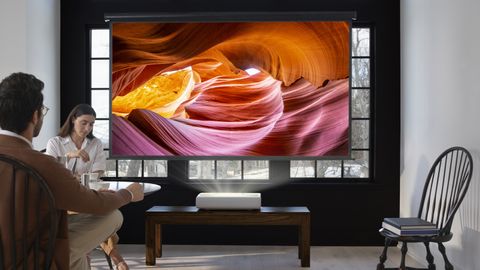TechRadar Verdict
The Samsung Premiere LSP9T is the most comprehensive and all-round successful living room-friendly projector solution we’ve seen to date. Picture quality is largely excellent, and sound quality may be the best we’ve heard from any projector. What’s more, while its £6,999 / $6,490 / AU$10,999 price might look steep at first glance, any TV able to deliver similarly large pictures would cost you tens of thousands more.
Pros
- +
Bright, colorful pictures
- +
Good in light and dark rooms
- +
Full TV-style smart system
Cons
- -
Some rainbow effect
- -
Some iffy presets for dark scenes
- -
OS can be sluggish
Why you can trust TechRadar
Editor's note
• Original review date: November 2020
• New Premiere 9 model coming out in 2024
• Launch price: US$6,499 / £6,999 / AU$10,999
• Target price now: $4,499 / £3,118 / AU$5,995
The Samsung Premiere LSP9T was the company’s first ultra short throw projector and it remains in the lineup, now at a discounted price. That’s because the LSP9T is due to be replaced in 2024 by the Premiere 9, another 4K UST that Samsung says will have improved brightness and better sound with the addition of Dolby Atmos processing. Nonetheless, the Premiere LSP9T is an impressive projector, and at $4,499 / £3,118 / AU$5,995 it’s now a much better value. The rest of this review remains as previously published.

One-minute review
Samsung is back in the home cinema projector market, after more than a decade away – and its Samsung Premiere flagship beamer is certain to impress.
The Premiere LSP9T’s ultra short throw design, 2800 lumens of laser-driven brightness, support for the latest 4K and HDR picture quality standards, powerful built-in audio system, and built-in tuner and smart system make it a true rival for a king-sized TV – especially as it produces mostly outstanding pictures.
Brightness and color volume are both exceptional for a projector, getting maximum value from an innovative new laser light source design. Here, for once, is a projector that actually handles HDR content well – despite that content being designed for TV rather than projection technologies.
The Premiere LSP9T’s pictures genuinely look 4K too, delivering a dense, cinematic image free of visible image structure even at its 130-inch maximum image size.
It’s not quite as ready for next-gen gaming as we’d have liked, and some fleeting color striping noise and occasional black level shortcomings sometimes reminds you a bit too obviously of the mechanics of its laser DLP optical system. But as an ultra short-throw projector, this may be the best example we’ve seen so far.
Price and availability
- The Samsung Premiere LSP9T is available across the world
- £6,999 / US$6,499 / AU$10,999 price tag
- A cheaper single-laser Premiere model, the LSP7T, is also available
Considering the two Premiere models are the first home entertainment projectors Samsung has released for over a decade, it’s impressive to see how widely Samsung is distributing them across the world. It’s a clear sign of Samsung’s manufacturing and distribution might – and, perhaps, its confidence in its new creation.
The flagship LSP9T’s £6,999 / $6,499 / AU$10,999 price looks high at first glance. LG’s similar Cinebeam HU85LS only costs £4,999, for instance, and the recently launched Optoma CinemaX P2 ultra short throw (UST) laser projector costs just £2,999. However, the Samsung model boasts an innovative triple laser design to boost color range and brightness, carries an unusually powerful audio system, and sports the most TV-like features and smart operating system of any projector to date.
Don’t forget, either, that Sony’s trailblazing VZ1000ES UST laser projector still costs £10,999, despite being available for around three years now.
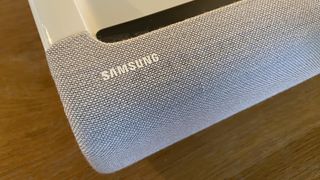
Design
- Ultra short throw design lets you place it right up to your wall
- Crisp, gloss white finish
- Powerful speakers are built into its rear side
The optical requirements of an ultra short-throw projector limit what the LSP9T can do in design terms. Within those limitations, though, the LSP9T actually looks pretty nice.
Its gloss white finish looks and feels premium, and is offset nicely by the grey fabric that sits over the speakers. Its rounded corners are a welcome domesticated touch too, and build quality is impressive.
The Premiere is slightly smaller than many ultra short-throw laser rivals, making it easier to fit on a sideboard. Another nice touch is the way its ergonomic, button-lite ‘smart’ remote control continues the crisp white finish theme.
Connections are all tucked away on the projector’s wall-facing side, making it easier to hide potential cable spaghetti. The only catch is that, due to the projector’s ultra short-throw design, thick cables can be a bit of struggle to squeeze in.
Connections are eye-catchingly numerous, too. It’s particularly good to see there are three HDMIs rather than the normal two, and an RF input that – unlike most UST projectors, including LG’s HU85LS – the Premiere LSP9T carries a fully functioning digital TV tuner. This underlines just how much Samsung sees its new Premiere projectors as alternatives to huge and prohibitively expensive LCD TVs.
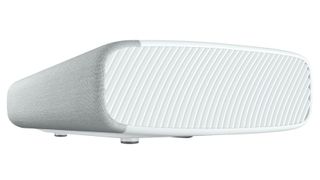
One of the HDMIs supports eARC functionality for passing lossless Dolby Atmos soundtracks out to compatible soundbars or AV receivers, and you’ll get a digital optical audio output thrown in too. For many people, though, the 40W 4.2-channel speaker system built into the Premiere LSP9T may well be good enough – at least in the short term.
An Ethernet port, meanwhile, lets you hardwire the projector into your network if you don’t want to use the projector’s Wi-Fi capability. You will definitely want to get the Premiere LSP9T on your network one way or the other, though, because unlike most projectors, this one carries the same full online smart TV system you get with Samsung 2020 TVs – the Tizen OS.
The last connection of note is a powered (5v 0.5A) USB port for accessing AV files from USB storage devices, or letting you attach something like an Amazon Fire TV stick (assuming you can squeeze one between the projector’s connections and the wall, that is).
I guess it would have been nice if the LSP9T’s HDMIs supported next-gen gaming features such as 4K/120Hz, variable refresh rates, and automatic game mode switching. But no other projector currently offers such functionality either.
The Premiere LSP9T’s design contains a couple of cool hidden features. You can, for instance, connect recent Galaxy phones to the projector for streaming just by tapping the phone against the projector’s bodywork. There’s also built-in Bluetooth headphone support, and 4.2 channels of sound – but more on that latter point in our audio section below.
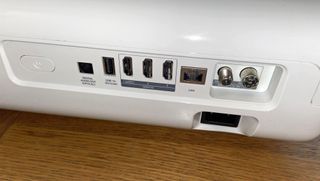
Smart TV
- Straightforward TV-like interface
- Comprehensive collection of content
- Includes voice control and Android/Apple Airplay wireless support
Screen sizes supported: 100 to 130 inches | Tuner: Freeview HD | 8K: No | HDR: Yes | Optical technology: Three-Laser DLP | Smart TV: Yes, Eden 2.0 | Dimensions: 550(w) x 141(h) x 367(d)mm | Weight: 11.5kg | 3D: No | Inputs: 3xHDMI 2.0 (with eARC), 1 x powered USB, RF input, optical digital audio output, bluetooth headphone output, Ethernet
The Premiere LSP9T fully implements Samsung’s excellent Tizen smart TV interface – the one used on most new Samsung TVs these days. That means you get the same economically-presented menus at the bottom of the screen, complete with pop-up content views above selected apps.
You can even issue verbal instructions to the TV via Samsung’s built-in Bixby system (with Alexa and Google Assistant supported via external listening devices if you have them).
Samsung’s smart system covers all the key video streaming apps, from Netflix and Amazon Prime Video to Apple TV and Disney Plus, with impressively comprehensive catch-up services for whichever region you’re in (you get all the key terrestrial broadcasters in the UK, for instance).
HDR and 4K are well supported across the provided apps, too – and as noted earlier, there’s excellent support for using the projector as a wireless display or speaker for files on your smartphones. The LSP9T is basically a fully functioning smart TV in a projector’s body.
Picture quality
- Exceptionally bright, colorful pictures
- Impressive 4K sharpness
- Some unexpected rainbow effect
The Premiere LSP9T has a number of unique picture quality features to its name that we’ll cover in the course of this part of the review – kicking off with its use of a triple laser system, where separate red, green and blue lasers create the picture without having to pass light through a color wheels as most DLP projectors do.
It’s this purity of the laser delivery, in fact, that makes the LSP9T’s pictures look even brighter in a dark room than the claimed 2,800 lumens would lead you to expect. This brightness is particularly helpful with high dynamic range sources, creating dazzling HDR images we simply haven’t seen on a projector of this price before. This holds true even with some ambient light in the room – a key achievement for a projector designed for the living room rather than a dedicated home cinema environment.
The direct RGB laser system ensures, too, that the projector’s extreme brightness is partnered by equally extreme color volume. Samsung claims that the Premiere LSP9T can cover 106% of the BT2020 HDR color range, and a massive 147% of the DCI-P3 color gamut used in digital cinemas – all powered by 16-bit 3D color mapping. With bright and mid-bright wide color gamut HDR movies, colors enjoy an intensity and range of tones beyond what we’d expect from a projector.
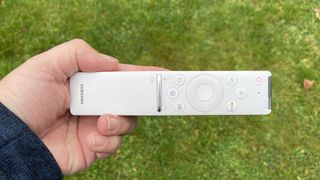
Normally, consumer projectors have to introduce a color filter to offer a wide color gamut, and these filters invariably lead to a much dimmer picture. Getting so much color with no loss of brightness on the LSP9T is therefore a sight for sore eyes. That’s especially true with the projector’s Dynamic mode, though saturation drops a little more than is necessary with the Standard setting.
Another exclusive picture feature of the LSP9T is its HDR10+ support. This means it can work with the extra scene-by-scene metadata the HDR10+ format provides, rather than merely the ‘static’ data you get with the industry standard HDR10 format. The result when playing HDR10+ sources is enhanced contrast (more distance between the darkest and brightest parts of the picture) and more detail refinement. As well as, more unexpectedly, reduced video noise in dark picture areas.
The LSP9T excels with native 4K sources. As usual with DLP projectors, it doesn’t carry a truly native 4K resolution in the way that Sony’s SXRD projectors do. Instead it uses Texas Instruments’ ultra-fast double flashing technology to get the mirrors on its DLP chip to deliver more than a single pixel of picture for each image frame.
This system is considered effective enough by the US’s Consumer Technology Association, though, to qualify as true 4K. And certainly 4K pictures look beautifully detailed, sharp and textured with the LSP9T. Not quite as pristine as the best Sony 4K models, perhaps, but a cut above most other ‘pseudo’ 4K DLP projectors.
It can retain that sharpness when there’s motion, too, thanks to the LSP9T carrying a projector-optimised version of the motion processing systems Samsung has been refining on its TVs for years now. You need to handle the motion processing with care, as the higher powered settings can cause distracting processing side effects. But the lowest setting does a good job of reducing judder without causing too many unpleasant trade offs.
Being able to take advantage of Samsung’s processing know-how also helps the LSP9T handle sub-4K content superbly well, too, adding density and genuine detail – to, say, HD sources – without the results looking forced or fake.
As spectacular as the LSP9T’s pictures are most of the time, though, they don’t completely escape the issues associated with the still relatively new world of laser projection.
For instance, very dark scenes can take on a rather grey appearance, especially if they’re in HDR and a bright highlight or two has to share screen space with darker patches of an image. This is especially true if you’re using the projector’s Movie or Filmmaker Mode picture preset, so much so that I don’t think many users will particularly enjoy either mode. Despite the UHD Alliance-approved Filmmaker Mode – the LSP9T being the first projector to be certified to use this – being designed to deliver a more accurate picture based on typical mastering standards.
Fortunately, contrast is better in the projector’s Bright or Standard modes. That’s probably because they make more aggressive use of a unique DynamicBlack feature that apparently amplifies dark video signals to boost bright areas before closing down the light source aperture to enhance the blackness of dark areas. The results still don’t deliver brilliant black levels, but they are good enough not to be a substantial distraction from all the (literally) brilliant stuff the projector is doing elsewhere.
Another issue that impacts the Dynamic and Standard presets is the loss of color finesse in very dark scenes. Skin tones and color blends can lose some of their subtle shading, looking a little rough and unnatural. However, content dark enough to really exacerbate this problem is pretty rare.
The projector’s input lag isn’t incredible, either, reaching a fairly average 56ms in its Game mode – but perhaps the most notable flaw is with the DLP rainbow effect.
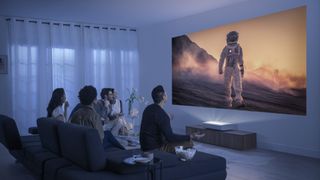
This phenomenon sees stripes of color flitting over small, bright picture highlights, and is quite common to see on DLP projectors that use a color wheel. But of course, the LSP9T doesn’t use a color wheel! Whatever its cause, the rainbow effect is undoubtedly there – so if you know yourself to be particularly susceptible to seeing it (sensitivity varies from person to person) it’s definitely something to think about.
The key point to remember about the LSP9T’s picture niggles, though, is that they’re arguably a necessity with current affordable laser technologies, and a side effect of the explosive strengths of the projector’s impactful and remarkably TV-like pictures.
Audio performance
- Audio beam technology for greater precision and a larger soundstage
- 40W of power in a 4.2-channel configuration
- Sounds better than many TVs
The Premiere LSP9T’s built-in sound system impresses in a number of ways. First, the distance the beam-based speaker system casts the sound away from the projector’s chassis is remarkable. As a result, the sound never seems to actually be coming from the physical location of the speakers on the LSP9T’s rear. The effect is closer to a wall of sound, complete with significant height and width, that seems to elevate everything to match the position of the onscreen pictures.
Dialogue remains correctly placed at the heart of this elevated soundstage, while specific effects are accurately positioned in the audio wall to tally up with the onscreen action. Detailing in even very complex movie mixes is good, and treble effects are delivered without harshness or clipping.
Bass is a little limited. There’s still enough of it, though, to ensure that even action movie soundtracks don’t end up sounding thin or flat. The projector never tries to push bass deeper than its speakers can sensibly go, either, meaning there’s no buzzing interference, crackling or drop outs. The speakers built into the LSP9T class would be good by TV standards, but are truly excellent by projector standards.
Should I buy the Samsung Premiere LSP9T?
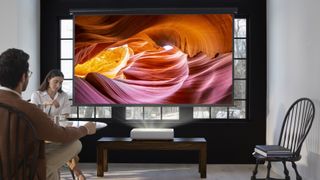
Buy it if...
You want a seriously massive picture in your living room
The Premiere LSP9T can deliver 130-inch pictures while only sitting on your sideboard just a few inches from your wall.
You want a projector that works in dark or bright conditions
The Premiere LSP9T’s brightness and color performance is strong enough to hold up against ambient light, and offer a great dark room viewing experience.
You want the functionality of a TV in a projector
With its smart TV features, built-in tuner, ultra-short throw design and bright, crisp, colorful pictures, the LSP9T combines the image size of a projector with the convenience of a TV.
Don't buy it if...
You’re susceptible to the rainbow effect
Despite not using a color wheel, the LSP9T can produce flashes of color striping over small bright highlights that can distract – especially if you are someone who is very susceptible to seeing the issue.
You want a dedicated home theatre projector
While the Premiere LSP9T succeeds as a ‘lifestyle’ projector for a regular living environment, you might prefer a model that focuses more on black level if you’re watching in a dedicated, blacked-out home theatre room.
You can’t afford it
While it just about offers enough unique features to justify its price, you can get other good UST laser projectors for substantially less – if you’re willing to sacrifice some picture performance and a few TV-aping features.
- Check out the best projectors you can buy
John has been writing about home entertainment technology for more than two decades - an especially impressive feat considering he still claims to only be 35 years old (yeah, right). In that time he’s reviewed hundreds if not thousands of TVs, projectors and speakers, and spent frankly far too long sitting by himself in a dark room.
